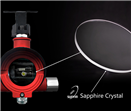
Time:2024-11-05
Sapphire, as a hard and brittle material that is difficult to process, has demonstrated high application value in fields such as optics, aerospace, semiconductors, and sensors. Its unique physical and chemical properties, such as high hardness, high wear resistance, and excellent transparency, make sapphire glass a material for many application fields. However, it is precisely these superior properties that have brought many challenges to the surface processing of sapphire. This article will explore the main surface processing methods of sapphire glass - grinding/polishing and micro groove grinding, and analyze the advantages and limitations of these technologies in practical applications.

1、 Grinding/Polishing Technology
Grinding/polishing is one of the commonly used methods in the surface processing of sapphire glass. It gradually reduces the particle size of the abrasive, combined with grinding and polishing solutions, to gradually remove the rough layer on the sapphire surface and obtain a smooth mirror like surface. This process can be roughly divided into the following steps:
1. Pre treatment: Clean the surface of sapphire glass to remove impurities, dust, and stains from the surface. This step is crucial because any small impurities can affect the quality and efficiency of subsequent processing.
2. Rough grinding: Use coarse sandpaper (such as 400 grit) for preliminary grinding to remove obvious defects and large unevenness on the surface of sapphire. The main purpose of this stage is to quickly reduce surface roughness and lay the foundation for subsequent fine processing.
3. Fine grinding: As the surface roughness decreases, gradually replace it with finer sandpaper (such as 600, 800, 1000, etc.) for more precise grinding. The goal of this stage is to further smooth the surface, reduce scratches and abrasions, and prepare for polishing.
4. Polishing: On the basis of fine grinding, the surface of sapphire is treated with a polishing machine and polishing solution. The choice of polishing solution has a direct impact on the polishing effect, and commonly used polishing solutions include metal polishing agents and polycrystalline alumina polishing agents. Through the rotation of the polishing machine and the chemical reaction of the polishing solution, the surface of sapphire gradually becomes smooth and bright, achieving a mirror effect.
The advantage of grinding/polishing technology is that it can achieve high surface smoothness and flatness, suitable for processing sapphire flakes and parts with relatively simple shapes. However, for sapphire parts with complex surfaces and grooves, traditional grinding/polishing methods are inadequate and difficult to achieve ideal machining results.
2、 Micro groove grinding technology
Micro groove grinding technology has emerged for sapphire parts with complex shapes. This technology uses small diameter diamond grinding heads (usually between 0.5~1mm in diameter) to precisely control the grinding depth and feed rate for micro groove machining or complex surface forming on sapphire surfaces.
1. Grinding head selection: The key to microgroove grinding is to choose the appropriate diamond grinding head. The diameter, shape, hardness, and particle size of the grinding head will all affect the machining effect. Due to the high hardness of sapphire, the grinding head needs to have sufficient strength and wear resistance to ensure the stability and accuracy of the processing.
2. Grinding parameter control: Grinding depth, feed rate, spindle speed and other parameters are key factors affecting machining quality and efficiency. Due to the brittleness of sapphire material, the grinding depth needs to be strictly controlled within a small range (generally 10-20 μ m) to avoid cracking or crushing. Meanwhile, a reasonable feed rate and spindle speed can ensure the smooth progress of the machining process, improve machining accuracy and surface quality.
3. Coolant usage: The use of coolant is crucial during the grinding process. It can effectively reduce the temperature of the grinding area, minimize the impact of thermal stress on sapphire materials, and prevent material deformation or cracking due to overheating. At the same time, coolant can also play a role in cleaning and lubricating, improving grinding efficiency and machining quality.
The advantage of micro groove grinding technology lies in its ability to perform high-precision machining on sapphire parts with complex surfaces and grooves, meeting the demand for high-precision sapphire parts in aerospace and other fields. However, due to the small diameter of diamond grinding heads, limited grinding depth, and relatively low strength and impact resistance of the grinding heads, it is necessary to strictly control various parameters during the machining process to ensure the stability and safety of the machining process.
Grinding/polishing and micro groove grinding are the main methods for surface processing of sapphire glass, each with its unique advantages and applicable scope. With the advancement of technology and continuous optimization of processes, these technologies will be applied and promoted in more fields. With the widespread application of sapphire materials in aerospace, semiconductor, sensors and other fields, the requirements for sapphire surface processing technology will also become increasingly high. Therefore, further research and development of efficient, precise, and environmentally friendly sapphire surface processing technologies are of great significance for promoting the development of related industries. At the same time, with the rise of intelligent manufacturing and digital processing technology, sapphire surface processing technology will also develop towards automation and intelligence, providing strong support for more applications.






Tel
Mobile phone
Customer service
TOP